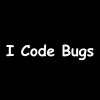爱写bug(ID:icodebugs)
作者:爱写bug
实现 strStr() 函数。
给定一个 haystack 字符串和一个 needle 字符串,在 haystack 字符串中找出 needle 字符串出现的第一个位置 (从0开始)。如果不存在,则返回 -1。
Implement strStr().
Return the index of the first occurrence of needle in haystack, or -1 if needle is not part of haystack.
Example 1:
Input: haystack = "hello", needle = "ll"
Output: 2
Example 2:
Input: haystack = "aaaaa", needle = "bba"
Output: -1
Clarification:
What should we return when needle is an empty string? This is a great question to ask during an interview.
For the purpose of this problem, we will return 0 when needle is an empty string. This is consistent to C’s strstr() and Java’s indexOf().
说明:
当 needle 是空字符串时,我们应当返回什么值呢?这是一个在面试中很好的问题。
解题思路(Java):
-
暴力穷举:
复杂度:时间 O(n^2) 空间 O(1)
字符串 a 从第一个索引开始 逐一匹配字符串 b 的第一个索引:
a[i++]==b[0],如果为true,则进入内循环字符串a从第i+j个字符开始与字符串b 第j个字符匹配:a[i+j]==b[j]
代码:
class Solution {
public int strStr(String haystack, String needle) {
if(needle.equals(""))return 0;
int haystackLen=haystack.length(),needleLen=needle.length();
char firstChar=needle.charAt(0);
for(int i=0;i<=haystackLen-needleLen;i++){
if(haystack.charAt(i)==firstChar){
int j=1;
for(;j<needleLen;j++){
if(haystack.charAt(i+j)!=needle.charAt(j)) break;
}
if(j==needleLen) return i;
}
}
return -1;
}
}
-
KMP算法:
复杂度:时间 O(n+m) 空间 O(M)
下面引用一组图片帮助理解(图片来源:https://blog.csdn.net/v_july_v/article/details/7041827 ):
说明: 图片中字符串haystack为:“BBC ABCDAB ABCDABCDABDE”,模式串 needle 为:“ABCDABD”
第一步开始匹配:
第二步匹配到第一个相同字符:
第三步两个字符串逐一向后匹配,直到到字符 D 与 空格 字符匹配失败,结束该轮次匹配:
第四步重新匹配,但不用从第二步的下一个字符 B 开始,因为空格字符前与模式字符串前6个字符已经匹配相同。既C字符之前的两个字符 AB 与空格字符前两个字符 AB 相同,两个字符串可直接从 空白 字符与 C 字符开始匹配:
可以看到图片中一下跳过了 haystack 五个字符ABCDAB 和 needle 的两个字符AB。优化思路很清晰。
代码:
class Solution {
public int strStr(String haystack, String needle) {
if(needle.equals("")) return 0;
int[] next = new int[needle.length()];
getNext(next, needle);// 得到next数组
// i是匹配串haystack的指针,j是模式串needle的指针
int i = 0, j = 0;
while(i < haystack.length() && j < needle.length()){
// 如果j=-1,即next数组中该字符为第一位,下标+1后,重新匹配
if(j == -1 || haystack.charAt(i) == needle.charAt(j)){
// 如果匹配成功,则自增1,匹配下一个字符
i++;j++;
} else {
j = next[j];// 如果匹配失败,则将j赋值next[j],避免匹配重复匹配
}
}
return j == needle.length() ? i - j : -1;
}
private void getNext(int[] next, String needle){
// k是前缀中相同部分的末尾,也是相同部分的长度
// j是后缀的末尾,即后缀相同部分的末尾
int k = -1, j = 0;
next[0] = -1;
while(j < needle.length() - 1){
// 如果k=-1,匹配失败,重新开始计算前缀和后缀相同的长度
// 如果两个字符相等,则在上次前缀和后缀相同的长度加1,继续下一段字符最大公共前后缀匹配
if (k == -1 || needle.charAt(j) == needle.charAt(k)){
k++;j++;
if (needle.charAt(j) != needle.charAt(k))
next[j] = k;
else
//因为不能出现p[j] = p[ next[j ]],所以当出现时需要继续递归,k = next[k] = next[next[k]],以减少重复部分的多余匹配
next[j] = next[k];
} else {
// 否则,前缀长度缩短为next[k]
k = next[k];
}
}
}
}
总结:
KMP算法优化的方向很明了,主要难点就在于对next数组的求法和理解,KMP算法不是本文的重点,如有兴趣深入了解,推荐一篇博文:https://blog.csdn.net/v_july_v/article/details/7041827
另外还有Sunday算法 是找到与模式字符串相同长度的源字符串 从右向左匹配,其中心思想为:
- 如果该字符没有在模式串中出现,直接从该字符向右移动位数 = 模式串长度 + 1。(因为源字符串含有该字符的相同长度字符串不可能匹配)
- 如果该字符在模式串中出现过,其移动位数 = 模式串中最右端的该字符到末尾的距离+1。
字符串haystackBBC ABC 与模式串needle ABCDABD 匹配,字符串haystack中的空格字符未在模式串needle 中出现,则可以直接跳过空格字符后面六个字符的匹配,因为包含空格字符的相同长度字符串都不可能匹配成功,所以可以跳过6个。
Python3:
说明:上面两种方法在所有语言都可行,只是语法不同,所以在py3中不再复现,仅展示一些py3特有的语法投机取巧解题。
利用py3内建函数**find()**直接得结果。
class Solution:
def strStr(self, haystack: str, needle: str) -> int:
return haystack.find(needle)
find() 方法描述
find() 方法检测字符串中是否包含子字符串 str ,如果指定 beg(开始) 和 end(结束) 范围,则检查是否包含在指定范围内,如果指定范围内如果包含指定索引值,返回的是索引值在字符串中的起始位置。如果不包含索引值,返回-1。如果子字符串为空,返回0。
语法
str.find(str, beg=0, end=len(string))参数
- str – 指定检索的字符串
- beg – 开始索引,默认为0。
- end – 结束索引,默认为字符串的长度。
利用py3字符出切片特性解决:
class Solution:
def strStr(self, haystack: str, needle: str) -> int:
for i in range(len(haystack)-len(needle)+1):
if haystack[i:i+len(needle)]==needle:#截取切片
return i
return -1
注:算法导论第32章:字符串匹配有完整的一章相关讨论。





 随时随地看视频
随时随地看视频



